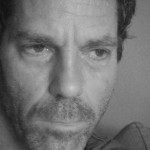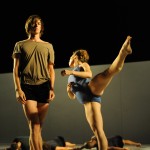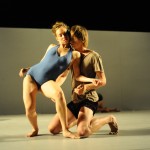Ohad Naharin is quite simply one of the foremost artists of our time, and for years now I have looked forward to the return of Israel’s Batsheva Dance Company, which he has helmed since 1990. I was pleasantly astonished that Naharin was willing to give an interview in advance of their San Francisco Performances run of Sadeh21, which opens tonight (November 6th, 2014) at the Yerba Buena Center for the Arts Theater. The Chronicle had space for only a portion of the interview, which you can read here, and has given me permission to share the rest of the interview, which I thought could be of interest to the dance world. The excised portions, which ran in the SF Chronicle Q and A, are indicated with ellipses. Naharin spoke by phone from Tel Aviv.

Ohad Naharin. Photo by Maxim Waratt.
Thank you so, so much for your time. I’m curious: What have you been working on today in the studio?
Naharin: The company has left this morning to Miami. I am flying to join them tomorrow. I’ll meet them in the theater Saturday. Today I was spending time with the junior company to prepare them for a show in Tel Aviv. Since I’m going away for a month, I try to spend as much time as I can with them. I am helping the dancers interpret the work. They join the company for two years, that’s the system of the junior company. For me it’s a great opportunity to take a fresh look at the work, modify.
Sadeh21 is from 2011. Are there things you’re still investigating within Sadeh21 even though it’s been in repertory for two years?
Yes, the process is ongoing. It’s constantly changing. We recognize new ideas that are better than our old ideas, and that happens often. And it connects to something that becomes apparent and physical in the way people perform the work. Sometimes we recognize a weak moment or want to play with what could be a better solution. So this is constantly happening. We just had two shows, and had the chance again to—it’s like a playground. We never try to do it just like it was done. We’re going beyond so that it is new to us.

Batsheva Dance Company in Sadeh21. Photo by Gadi Dagon.
What engaged you this time as you put it back together?
This time it was about helping the dancers interpret it. Also, so much is about the attention to small details. Something to do with the timing of different things. Elimination—erasing what you think is noisy. Not in terms of the sound but in terms of . . . It’s about kind of trying to get to the essence of things and then creating space for the dancers to feel free. Not about minimizing what they do but, about giving them . . . I’m thinking about this particular . . . because they know the work so well now, we are experimenting with how we listen to our body, it has to do with how we play with dynamics, play with texture. A lot of what I like to discover with the dancers right now is echo. In the body, there’s always an echo. Sometimes dancers minimize the echo, or they are managed by the echo. It’s nice to create the texture and the quality of the movement and make them very unique. To be conscious of echoes, this is what we’re working.
We’re talking about the choices of volume. And volume for us is not just how high you can go but how low you can go.
Do you dance? You should join our Gaga class.
I do dance a little, thank you for the invitation. I saw the listing for the Gaga class and am hoping to go.
I’m sorry, I cannot hear you very well. Could you . . .
I’m so sorry. Can you hear me better now? I’ve been thinking about your work and its contasts—there’s a lot of paradox you play with in your work. For instance, the dancers are so highly individual but also so mesmerizingly in unison. Can you talk about being comfortable with paradox?
Maybe because the distance between the things that seem to be extremes, sometimes the distance is not so far, and also sometimes not so important. I think it has to do with what I care for. I don’t care for extremes. I care for how extremes can create range. It’s more about the grey between. It’s not about being at the edge. It’s that the edge clarifies the field and what I can play with. It’s much more about mixing things and abolishing, actually, the clarity of borders. Extremes are black and white and I like shades. Also what I’m really interested in is working with my dancers, watching other people work—in moments where I stop judging it in terms of bad good excellent and much more want to be in a sense of awe. This moment of awe that the dancers can produce will abolish all judgment. It’s very different to approach something by trying to be excellent and by watching something open. It’s about approaching things from an angle where work can be fresh and surprising and can break the rules that we make. And not being embarrassed to laugh at myself, and the dancers, being laughed at by them. And we connect to places where we yield. And then we realize new possibilities.
[ . . . ]
I do have clear intentions sometimes and want people to understand my intentions. Free association interpretation is ok too but when I have a clear intention and mean something, I want to communicate it with you. If you understand something else, fine, but I feel that we have missed something.
But many times what I mean is not in the sense of story or an idea that can be described. For instance, in Minus 16. I mean it was something to do with ritual, accumulation, with things that you need to recognize. Rhythm, acceleration, the relationship between movement and music, the clarity of form that brings some kind of content. If I meant it and someone does not understand it, then I am totally missing that person, and he is missing you.
[ . . . ]

Batsheva Dance Company in Sadeh21. Photo by Gadi Dagon.
I understand “sadeh” means field, as in investigations of a field. Can you talk about the intentions of this work?
We can talk about an idea, these were my intentions. But at the heart of it, it has to do with a sublimation that I try to make of my imagination to my skills, and how I meet my ability to articulate my ideas to these dancers so they can make this sublimation with their own skill. And then how together we come up with a mix of content and form that you cannot even separate between the two. Then you can talk about the structure—how the piece starts with a series of solos in which you meet all the dancers, for example. And it ends also with a series of solos. I’m telling technical things, but it was to do with the spirit of the work.
The kind of emotional journey that I take the dancers and I take you on, if you join me—it’s for a reason. It’s about creating a universe that belongs to the piece, to the stage. Many times it’s not about how we reflect on life, it’s how the work reflects on itself. In it is its intention. It’s not that I ask you to reflect on your life or your experience even though you try to bring this experience in order to be engaged with the universe I create. I’m sorry if I am not clear.
No, no, I think you’re very clear.
[ . . . ]
I’ve also been thinking about your work and William Forsythe’s—he also working with parameters of the experiment and rules of the playground. I know you two are near contemporaries and you have made work for Ballett Frankfurt. Do you two have a relationship?
I really love Bill’s work. I’ve learned from him a lot. I’ve met him several times; I worked with his company years ago. I try to follow his work; it’s very hard because we are far apart, I don’t see his company much though I try to follow. I think we communicate with each other through the dancers we work with. We’ve tested people with our work and they teach each other, influence each other. I think we feel each other. I hope.
[ . . . ]
I have just one more question, about Gaga—and I can’t wait to take the class. I think to many people the movement vocabulary of Gaga or the result of it at moments may look explosive and violent. But I’ve heard so much testimony that Gaga is healing. Can you speak to that? How is it that a movement practice that can sometimes look so explosive is healing?
First of all, in order to be explosive, the body must collapse. It much let go. It cannot, uh—it should just—try, while you’re talking to snap your fingers. Are you snapping now? Can you tense your fingers? Can you tense your fingers and snap? Now you relax your hand. Can you relax your hand and snap? So you see how much you need to be soft, you need to be soft in order to snap. Now snapping is a very explosive action, actually. So we teach the body to be available for snapping, available to explode. We don’t explode much. We’re much more spending the time to yield and let go. And then we become available to explode. So, this idea of being able to be soft, to be efficient in an animalistic way, efficient, and to connect to gravity and the efficiency of movement is actually when we create balance in the body, awake places of atrophy. And instead of macho power we get longevity and things that are much more healthy and good for our spirit and physiology. Things like that.
Thank you so much, especially for the example of the finger snapping which captures it right away. I appreciate your time. I feel tremendously fortunate to speak to you. Thank you for the work that you do.

Add Comment